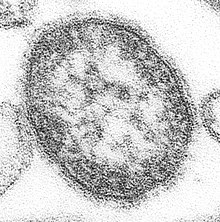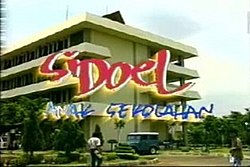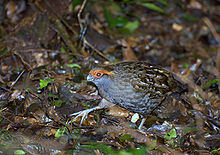홍역모빌리바이러스
Measles morbillivirus| 홍역모빌리바이러스 | |
|---|---|
 | |
| 홍역모빌리바이러스 전자 현미경 사진 | |
| 바이러스 분류 | |
| (순위 미지정): | 바이러스 |
| 영역: | 리보비리아 |
| 왕국: | 오르토나비라과 |
| 문: | 네가르나비리코타 |
| 클래스: | 몬지비리세테스 |
| 주문: | 모노네가비랄레스 |
| 패밀리: | 파라믹소바이러스과 |
| 속: | 모빌리바이러스 |
| 종류: | 홍역모빌리바이러스 |
| 동의어[1] | |
| 홍역바이러스 | |
홍역 모빌리바이러스(MeV)는 홍역 바이러스라고도 불리며, 파라믹소바이러스과(Paramyxoviridae)에 속하는 모빌리바이러스속의 외가닥형 비분할 RNA 바이러스이다.이것이 홍역의 원인입니다.인간은 바이러스의 자연 숙주이다; 동물 저수지는 존재하지 않는다.
질병
이 바이러스는 일시적이지만 심각한 면역 억제를 유발하는 호흡기 에어로졸에 의해 전염되는 전염성이 높은 질병인 홍역을 일으킨다.증상은 발열, 기침, 콧물, 염증, 그리고 아래 1, 2 어금니 반대쪽 구강 점막에서 볼 수 있는 전신성 황반성 홍반 발진, 그리고 병적인 코플릭 반점을 포함한다.이 바이러스는 기침과 재채기를 통해 개인적 접촉이나 분비물과의 직접적인 접촉을 통해 전파된다.
레플리케이션 사이클
엔트리
홍역 바이러스는 바이러스 표면에 두 개의 외피 당단백질인 헤마글루티닌(H)과 막융합단백질(F)을 가지고 있다.이 단백질들은 숙주 세포의 결합과 침입에 책임이 있다.H단백질은 수용체 부착을 매개하고 F단백질은 바이러스 외피와 세포막의 융합을 일으킨다.또한 F단백질은 감염된 세포를 합성세포를 형성하는 인접한 비감염세포와 직접 융합시킬 수 있다.지금까지 H 단백질에 대한 세 가지 수용체가 확인되었다: 보체 조절 분자 CD46, 시그널링 림프구 활성화 분자(SLAMF1) 및 세포 접착 분자 넥틴-4.[2]야생형 및 백신 균주의 경우 CD150(SLAM 또는 SLAMF1)[3][4] 및/또는 넥틴-4(Poliovirus-Receptor-Like 4(PVRL4)[5][6]의 세포외 도메인이 주로 세포 진입 수용체로 작용한다.야생형 바이러스 균주와 에드먼스턴 균주에서 파생된 모든 현대 백신 균주도 CD46을 [7][8]사용한다.
게놈 리플리케이션 및 바이러스 어셈블리
일단 바이러스가 숙주 세포에 들어가면, 그것의 음의 ssRNA(단일 가닥 RNA) 가닥은 바이러스리온에 포함된 RNA의존성 중합효소를 사용하여 양의 감각 복사를 만드는 템플릿으로 사용됩니다.그런 다음 이 복사본을 사용하여 새로운 네거티브 복사본을 만드는 등 많은 ssRNA 복사본을 만듭니다.그리고 나서 긍정적인 감각의 ssRNA는 숙주 리보솜에 의해 질량 번역되어 모든 바이러스 단백질을 생산한다.그리고 나서 바이러스는 단백질과 부정적인 감각의 ssRNA로부터 조립되고, 세포는 용해되어 새로운 바이러스 입자를 방출하고 [9]순환을 재개할 것이다.
게놈 및 비리온 구조
바이러스의 RNA 게놈은 RNA의존성 RNA중합효소(RdRp)를 나타내는 6가지 주요 단백질인 뉴클레오단백질(N), 포스포단백질(P), 매트릭스단백질(M), 퓨전단백질(F), 헤마글루티닌(H), 라지단백질(L)[10]을 코드한다.바이러스 게놈은 또한 두 개의 비구조 단백질 C와 V를 코드화한다.이러한 비구조적 단백질은 선천적인 면역 길항제이다; 그것들은 바이러스가 숙주의 면역 반응에서 벗어나도록 돕는다.비리온 게놈 RNA는 N, L, P 단백질과 복합체를 형성하고 있다.N, P 및 M 단백질은 RdRp에 의해 RNA 합성을 조절한다.바이러스는 지질막으로 둘러싸여 있고 당단백 H와 F는 이 지질막과 연관된 바이러스 표면 단백질이다.
진화
홍역 바이러스는 소를 [11]감염시킨 지금은 근절되었지만 이전에는 널리 퍼진 린더페스트 바이러스에서 진화했다.시퀀스 분석에 따르면 이 두 바이러스는 11세기와 12세기에 가장 많이 분기했을 것으로 추정되지만, 빠르면 5세기에는 이 [11]계산의 95% 신뢰 구간 내에 속합니다.
다른 분석에서는 강력한 정제 선택이 [12]작동할 때 나이를 과소평가하는 기법의 경향 때문에 차이가 더 오래되었을 수 있다고 제안했습니다.7세기 [10][13]이전의 기원에 대한 언어학적 증거가 있다.현재의 유행병은 20세기 초에 진화했다. 아마도 1908년에서 [14]1943년 사이였을 것이다.
유전자형
홍역 바이러스 게놈은 전형적으로 15,894개의 뉴클레오티드의 길이로 8개의 [15]단백질을 암호화한다.WHO는 현재 8군데의 홍역을 인정하고 있다.서브타입은 A1, D2 등의 숫자로 설계됩니다.현재 23개의 서브타입이 인식되고 있습니다.N의 C 말단 150 아미노산을 코드하는 450 뉴클레오티드는 홍역 바이러스 분리 유전자형에 필요한 최소 염기서열 데이터 양이다.유전자형 분류 계획은 1998년에 도입되었고 2002년과 2003년에 확대되었다.
홍역 유전자형은 다양하지만 홍역 혈청형은 하나뿐이다.홍역에 대한 항체는 헤마글루티닌 단백질에 결합한다.따라서, 한 유전자형에 대한 항체(백신주 [16]등)는 다른 모든 유전자형에 대해 보호한다.
주요 유전자형은 국가마다 다르며, 해당 국가 또는 지역 내 홍역 순환 현황도 다르다.홍역 바이러스의 풍토병은 2000년까지 미국과 호주에서, [17]2002년까지 미국에서 중단되었다.
감염
감염 초기 CD150(SLAMF1) 수용체를 통한 홍역 바이러스는 대식세포나 수지상세포 [18][19][20]등 숙주호흡기에 위치한 면역세포를 감염시킨다.그들은 바이러스를 림프기관으로 옮기고, 림프기관에서 조직적으로 퍼진다.감염의 후기 단계에서, 바이러스는 또한 SLAMF1 수용체를 통해 B[21] 세포와 T 림프구를[22] 포함한 다른 면역 세포 유형에도 감염된다.또한 기도에 있는 상피세포를 감염시킵니다.이 세포들은 넥틴-4 수용체와 감염된 면역 세포와의 세포 간 접촉을 통해 감염된다.상피세포의 감염은 바이러스가 [23][24]기류를 통해 방출되도록 한다.
레퍼런스
- ^ "ICTV Taxonomy history: Measles morbillivirus". International Committee on Taxonomy of Viruses (ICTV). Retrieved 15 January 2019.
- ^ Lu G, Gao GF, Yan J (2013). "The receptors and entry of measles virus: a review". Sheng Wu Gong Cheng Xue Bao (in Chinese). 29 (1): 1–9. PMID 23631113.
- ^ Tatsuo, Hironobu; Ono, Nobuyuki; Tanaka, Kotaro; Yanagi, Yusuke (24 August 2000). "SLAM (CDw150) is a cellular receptor for measles virus". Nature. 406 (6798): 893–897. Bibcode:2000Natur.406..893T. doi:10.1038/35022579. ISSN 0028-0836. PMID 10972291. S2CID 4409405.
- ^ Tatsuo, Hironobu; Yanagi, Yusuke (March 2002). "The Morbillivirus Receptor SLAM (CD150)". Microbiology and Immunology. 46 (3): 135–142. doi:10.1111/j.1348-0421.2002.tb02678.x. ISSN 0385-5600. PMID 12008921. S2CID 30651799.
- ^ Mühlebach, Michael D Mateo, Mathieu Sinn, Patrick L Prüfer, Steffen Uhlig, Katharina M Leonard, Vincent H J Navaratnarajah, Chanakha K Frenzke, Marie Wong, Xiao X Sawatsky, Bevan Ramachandran, Shyam Mccray Jr, Paul B Cichutek, Klaus Von Messling, Veronika Lopez, Marc Cattaneo, Roberto. Adherens junction protein nectin-4 is the epithelial receptor for measles virus. OCLC 806252697.
{{cite book}}: CS1 maint: 여러 이름: 작성자 목록(링크) - ^ Noyce, Ryan S.; Richardson, Christopher D. (20 June 2012). "Nectin 4 is the epithelial cell receptor for measles virus". Trends in Microbiology. 20 (9): 429–439. doi:10.1016/j.tim.2012.05.006. ISSN 0966-842X. PMID 22721863.
- ^ Erlenhöfer, Christian; Duprex, W. Paul; Rima, Bert K.; ter Meulen, Volker; Schneider-Schaulies, Jürgen (1 June 2002). "Analysis of receptor (CD46, CD150) usage by measles virus". Journal of General Virology. 83 (6): 1431–1436. doi:10.1099/0022-1317-83-6-1431. ISSN 0022-1317. PMID 12029158.
- ^ Lin, Liang-Tzung; Richardson, Christopher (20 September 2016). "The Host Cell Receptors for Measles Virus and Their Interaction with the Viral Hemagglutinin (H) Protein". Viruses. 8 (9): 250. doi:10.3390/v8090250. ISSN 1999-4915. PMC 5035964. PMID 27657109.
- ^ Jiang, Yanliang; Qin, Yali; Chen, Mingzhou (16 November 2016). "Host–Pathogen Interactions in Measles Virus Replication and Anti-Viral Immunity". Viruses. 8 (11): 308. doi:10.3390/v8110308. ISSN 1999-4915. PMC 5127022. PMID 27854326.
- ^ a b Griffin DE (2007). "Measles Virus". In Martin, Malcolm A.; Knipe, David M.; Fields, Bernard N.; Howley, Peter M.; Griffin, Diane; Lamb, Robert (eds.). Fields' virology (5th ed.). Philadelphia: Wolters Kluwer Health/Lippincott Williams & Wilkins. ISBN 978-0-7817-6060-7.
- ^ a b Furuse Y, Suzuki A, Oshitani H (2010). "Origin of measles virus: divergence from rinderpest virus between the 11th and 12th centuries". Virol. J. 7: 52. doi:10.1186/1743-422X-7-52. PMC 2838858. PMID 20202190.
- ^ Wertheim, J. O.; Kosakovsky Pond, S. L. (2011). "Purifying Selection Can Obscure the Ancient Age of Viral Lineages". Molecular Biology and Evolution. 28 (12): 3355–65. doi:10.1093/molbev/msr170. PMC 3247791. PMID 21705379.
- ^ McNeil, W. (1976). Plagues and Peoples. New York: Anchor Press/Doubleday. ISBN 978-0-385-11256-7.
- ^ Pomeroy LW, Bjørnstad ON, Holmes EC (February 2008). "The evolutionary and epidemiological dynamics of the paramyxoviridae". J. Mol. Evol. 66 (2): 98–106. Bibcode:2008JMolE..66...98P. doi:10.1007/s00239-007-9040-x. PMC 3334863. PMID 18217182.
- ^ Phan, MVT; Schapendonk, CME; Oude Munnink, BB; Koopmans, MPG; de Swart, RL; Cotten, M (29 March 2018). "Complete Genome Sequences of Six Measles Virus Strains". Genome Announcements. 6 (13). doi:10.1128/genomeA.00184-18. PMC 5876482. PMID 29599155.
- ^ "Measles". Biologicals — Vaccine Standardization. World Health Organization. 11 March 2013. Archived from the original on 1 May 2014.
- ^ "No endemic transmission of measles in the Americas since 2002". Pan American Health Organization. 14 February 2017. Retrieved 11 September 2017.
- ^ Ferreira, Claudia S. Antunes; Frenzke, Marie; Leonard, Vincent H. J.; Welstead, G. Grant; Richardson, Christopher D.; Cattaneo, Roberto (15 March 2010). "Measles Virus Infection of Alveolar Macrophages and Dendritic Cells Precedes Spread to Lymphatic Organs in Transgenic Mice Expressing Human Signaling Lymphocytic Activation Molecule (SLAM, CD150)". Journal of Virology. 84 (6): 3033–3042. doi:10.1128/JVI.01559-09. ISSN 0022-538X. PMC 2826031. PMID 20042501.
- ^ Leonard, Vincent H.J.; Sinn, Patrick L.; Hodge, Gregory; Miest, Tanner; Devaux, Patricia; Oezguen, Numan; Braun, Werner; McCray, Paul B.; McChesney, Michael B.; Cattaneo, Roberto (1 July 2008). "Measles virus blind to its epithelial cell receptor remains virulent in rhesus monkeys but cannot cross the airway epithelium and is not shed". The Journal of Clinical Investigation. 118 (7): 2448–2458. doi:10.1172/JCI35454. ISSN 0021-9738. PMC 2430500. PMID 18568079.
- ^ Allen, Ingrid V.; McQuaid, Stephen; Penalva, Rosana; Ludlow, Martin; Duprex, W. Paul; Rima, Bertus K. (9 May 2018). "Macrophages and Dendritic Cells Are the Predominant Cells Infected in Measles in Humans". mSphere. 3 (3). doi:10.1128/mSphere.00570-17. ISSN 2379-5042. PMC 5956143. PMID 29743202.
- ^ Laksono, Brigitta M.; Grosserichter-Wagener, Christina; Vries, Rory D. de; Langeveld, Simone A. G.; Brem, Maarten D.; Dongen, Jacques J. M. van; Katsikis, Peter D.; Koopmans, Marion P. G.; Zelm, Menno C. van; Swart, Rik L. de (15 April 2018). "In Vitro Measles Virus Infection of Human Lymphocyte Subsets Demonstrates High Susceptibility and Permissiveness of both Naive and Memory B Cells". Journal of Virology. 92 (8): e00131-18. doi:10.1128/JVI.00131-18. ISSN 0022-538X. PMC 5874404. PMID 29437964.
- ^ Koethe, Susanne; Avota, Elita; Schneider-Schaulies, Sibylle (15 September 2012). "Measles Virus Transmission from Dendritic Cells to T Cells: Formation of Synapse-Like Interfaces Concentrating Viral and Cellular Components". Journal of Virology. 86 (18): 9773–9781. doi:10.1128/JVI.00458-12. ISSN 0022-538X. PMC 3446594. PMID 22761368.
- ^ Ludlow, Martin; Lemon, Ken; de Vries, Rory D.; McQuaid, Stephen; Millar, Emma L.; van Amerongen, Geert; Yüksel, Selma; Verburgh, R. Joyce; Osterhaus, Albert D. M. E.; de Swart, Rik L.; Duprex, W. Paul (April 2013). "Measles Virus Infection of Epithelial Cells in the Macaque Upper Respiratory Tract Is Mediated by Subepithelial Immune Cells". Journal of Virology. 87 (7): 4033–4042. doi:10.1128/JVI.03258-12. ISSN 0022-538X. PMC 3624209. PMID 23365435.
- ^ Singh, Brajesh K.; Li, Ni; Mark, Anna C.; Mateo, Mathieu; Cattaneo, Roberto; Sinn, Patrick L. (1 August 2016). "Cell-to-Cell Contact and Nectin-4 Govern Spread of Measles Virus from Primary Human Myeloid Cells to Primary Human Airway Epithelial Cells". Journal of Virology. 90 (15): 6808–6817. doi:10.1128/JVI.00266-16. ISSN 0022-538X. PMC 4944272. PMID 27194761.
외부 링크
- "Measles virus". International Committee on Taxonomy of Viruses.







